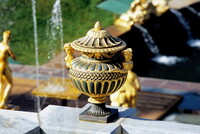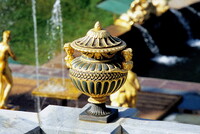| dc.coverage.spatial | Site: Peterhof (Petrodvorets, Rossiya, Russia) | en_US |
| dc.coverage.temporal | ca. 1709-1830 (creation) | en_US |
| dc.creator | Rastrelli, Bartolomeo Francesco | en_US |
| dc.creator | Le Blond, Jean-Baptiste-Alexandre | en_US |
| dc.creator | Stakenschneider, Andrei Ivanovich | en_US |
| dc.date | 1709-1830 | en_US |
| dc.date.accessioned | 2013-01-29T17:21:49Z | |
| dc.date.available | 2013-01-29T17:21:49Z | |
| dc.date.issued | 1709-1830 | en_US |
| dc.identifier | 188197 | en_US |
| dc.identifier.other | archrefid: 1694 | en_US |
| dc.identifier.uri | http://hdl.handle.net/1721.3/96733 | |
| dc.description | Urn on the east cascade; The outlines of the park took shape in the first half of the 18th century. South of the palace is the Upper Park with five fountains, including Neptune. To the north, between the palace and the sea, is the Lower Park, with the Grand Cascade and complex of fountains, which were begun in 1710 to commemorate the Russian victory over the Swedes in the Great Northern War (1700-1721). The compositional centre of the Grand Cascade is the monumental sculpture Samson Rending the Lion’s Jaws; the original lead statue was replaced in 1802 with a bronze (lost 1944; reconstructed 1947) by Mikhail Kozlovsky. The triumphal theme is repeated in the other sculptures in the cascade, by Bartolomeo Carlo Rastrelli, Fedot Shubin, Feodosy Shchedrin and Ivan Martos. In the eastern part of the Lower Garden, on an artificial embankment at the edge of the sea, is Peter I’s miniature palace, Monplaisir and its small garden with five fountains (1721-1723). The Marly Palace (1721-1724; by Braunstein) is on the west side of the Lower Park; it has gardens, ponds, fountains and a cascade based on that (destr. 18th century) at the château of Marly. The Hermitage (1721-1726; by Braunstein and others) is a tiny two-storey pavilion with a moat and drawbridge. At the end of the 18th century and in the 19th a series of landscaped parks was created: the English park; the Aleksandriya (1826-1829; by Adam Menelas) with buildings in a Gothic Revival style; the Aleksandrinsky Park, with pavilions in an eclectic style; and the Belvedere Palace (1853-1856; by Andrey Shtakenshneyder). Source: Grove Art Online; http://www.oxfordartonline.com/ (accessed 6/17/2009) | en_US |
| dc.rights | © Scott Gilchrist, Archivision, Inc. | en_US |
| dc.subject | architectural exteriors | en_US |
| dc.subject | decorative arts | en_US |
| dc.subject | mythology (Classical) | en_US |
| dc.subject | plants | en_US |
| dc.subject | rulers and leaders | en_US |
| dc.subject | Peter I, Emperor of Russia, 1672-1725 | en_US |
| dc.subject | Eighteenth century | en_US |
| dc.title | Peterhof; Fountains and Gardens | en_US |
| dc.title.alternative | Peterhof Park | en_US |
| dc.type | image | en_US |
| dc.rights.access | Licensed for educational and research use by the MIT community only | en_US |
| dc.identifier.vendorcode | 1A2-R-SP-P-2-B18 | en_US |
| vra.culturalContext | Russian | en_US |
| vra.technique | gardening construction (assembling) | en_US |
| vra.worktype | park (recreation area) | en_US |
| vra.worktype | garden structure | en_US |
| vra.worktype | fountain | en_US |
| vra.worktype | garden | en_US |
| dc.contributor.display | Andrei Ivanovich Stakenschneider (Russian architect, 1802-1865); Bartolomeo Francesco Rastrelli (Italian architect, 1700-1771); Jean-Baptiste-Alexandre Le Blond (French architect, 1679-1719) | en_US |



